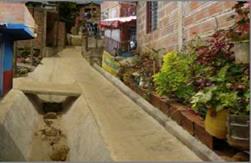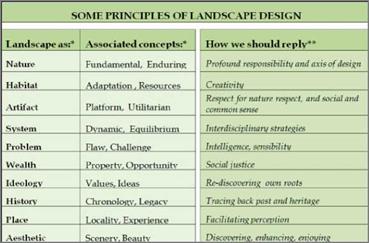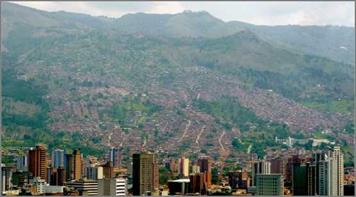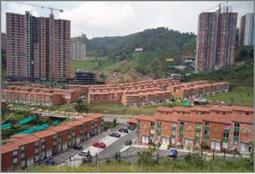To start, it is pertinent to select some concepts that express our interpretation of landscape and simultaneously support the landscape axis of the research. For such purpose, some substantial reference parts on the matter have been extracted, and are presented as follows.
The first reference is taken from La Gro’s Ten perceptions of landscape meaning (La Gro 2008, pg.157) and adapted to drive the basis for the intended guidelines (Table 2). The aim of replying to the author ideas was to establish a starting point that would compromise the research team attitude from the beginning.
|
Table 2. Some principles of landscape design. *Taken from La Gro James A. Jr. 2008. **Proposed by the author of this chapter. |
The second reference comes from Lucia Costa who says that landscape and city are destined to a permanent complicity relationship and supports herself on Lawrance Halprin (1981) when the landscape designer argue that the most interesting cities are those that allow to reveal that complicity (Costa 2006). These ideas encompass what we are daring to pursue through our work.
The third reference is taken from Anne W. Spirn who referring to her book The Granite Garden, says: after its publication in 1984, I was surprised how many people, including scientists and naturalists who refused to accept or ignored the evidence that human settlements, including cities, are part of the natural world. I have found that those ideas about nature and what is natural come from very deep feelings and beliefs. These views are personal and varied, and to change them is not simply a matter of some verbal arguments convincing, but to reach both the mind and the heart of people. Photography and landscape architecture are powerful ways to help people to feel, as well as reflect on the place of humans in nature. (Spirn, 2006). This reference drives our thought into the sensible and human side of landscape that could not be absent in a serious and complete landscape project.
From a more practical point of view it was agreed by the research team that the landscape of borders has to be seen at least in three scales:
– The panoramic scale that shows the fact and let appreciate it in terms of composition: line, texture, colour and form It is particularly evident in the situation of the valley always present wherever the observer is positioned (Figure 10).
|
Fig. 10. Panoramic view on the west side of the Aburra valley basin. Photo C D Montoya |
– The middle distance scale where other aspects of landscape, in addition to the composition itself, emerge as the identification of local particularities. Here the rugged relief besides the unfeeling inclusion of buildings and civil works make landscape reading even more intricate (Figure 11) and 12).
|
Fig. 11. Middle distance view of a place where a stream is hidden. |
|
|
Fig. 12. Civil works on a natural environment
– The experiential scale, in which the other senses, besides the sight, gain prominence in the perception of the place (Figures 13 and 14).

 |
Fig. 13. Experiential landscape
Fig. 14. Extremely hard stream treatment






